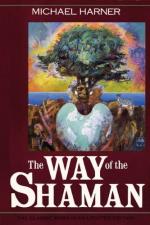
|
| Name: _________________________ | Period: ___________________ |
This test consists of 15 multiple choice questions and 5 short answer questions.
Multiple Choice Questions
1. After Harner is awakened from his maikua trance, what is he given?
(a) Pork and mango chutney.
(b) Peaches and grubs.
(c) Warm beer and monkey meat.
(d) Warm oolong tea and papaya seeds.
2. With the help of spirit helpers and two tsentak inside his mouth, the shaman can help the patient by:
(a) Vomiting out the intruder.
(b) Frightening the intruder out.
(c) Smoking out the intruder.
(d) Swallowing the intruder.
3. What similarity does Harner point out between shamanism and science?
(a) Both require much training and discipline.
(b) Both are in awe of complexity and the magnificence of nature.
(c) Both require a curious mind, an open heart, and a sense of adventure.
(d) Both are available to the serious student of reality.
4. What happens in the state a shaman reaches, known as a type of ecstasy?
(a) The shaman's spirit goes on a type of auto-pilot mode.
(b) The shaman taps into perfect bliss.
(c) The soul leaves the body, either ascending or descending.
(d) A higher entity takes over and controls the shaman's body.
5. How is a shamanic state of consciousness, or SSC, achieved?
(a) By chanting songs passed down by tribal peoples and drinking fermented coffee.
(b) By calling upon spirit guides to pull the shaman's spirit out of the body and hurl it to the heavens.
(c) By entering a trance state and using methods of cosmic geography and nonordinary reality.
(d) By drinking nettle tea and fasting for five days.
6. Harner's reports of the rituals, symbols, and visions of the different tribes he observes are what?
(a) Similar.
(b) Disturbing.
(c) Foreign.
(d) Simplistic.
7. Shamans from Venezuela, North America, Australia, and other regions all report having similar what?
(a) Dietary needs.
(b) Concerns.
(c) Spirit guides.
(d) Experiences.
8. To learn more about shamanism, what does Harner do?
(a) Lives among tribal people to learn their shamanic ways.
(b) Enrolls in a class on shamanism at his community college.
(c) Asks the oldest shaman in the world to mentor him.
(d) Assembles a team of seven shamans from every corner of the world.
9. Shaman's do not challenge the validity of someone else's what?
(a) Drug addiction.
(b) Claims of being a shaman.
(c) Healing methods.
(d) Authentic first-hand experience.
10. Why is Harner afraid to take maikua?
(a) He's heard stories of death and madness that result from taking it.
(b) Its bitterness leaves his mouth dry and burns his throat.
(c) Nobody has ever taken maikua and lived to tell about it.
(d) It is a poison that affects the liver and impairs eyesight.
11. Which of the following do reputable shamans NOT do?
(a) Take on patients' symptoms.
(b) Practice clairvoyance.
(c) Cross realities at will.
(d) Make deals with evil spirits.
12. The author emphasizes that not all tribes use what in their shamanic practices?
(a) Chants.
(b) Shamans.
(c) Drugs.
(d) Rituals.
13. What are guardian spirits called in Siberia?
(a) Guardian angels.
(b) Angelic beings.
(c) Warning spirits.
(d) Tutelary spirits.
14. What are guardian spirits known as in Australia?
(a) Assistant totem.
(b) Angelic assistant.
(c) Totem angel.
(d) Spirit of assistance.
15. Why might a shaman work in darkness?
(a) To minimize interference from the sun's rays.
(b) To hide from negative entities.
(c) To achieve the most profound visions.
(d) To conceal his or her expressions.
Short Answer Questions
1. Through numerous examples, the author shows the commonality of experiences by shamans regardless of what?
2. What do various cultures report noticing the shaman give off when in a shamanic state of consciousness?
3. What does Harner point out about the Lakota Sioux and the Coast Salish tribes?
4. In "The Way of the Shaman," the author shows similarities between:
5. What does the Jivaro shaman help Harner acquire?
|
This section contains 662 words (approx. 3 pages at 300 words per page) |

|




